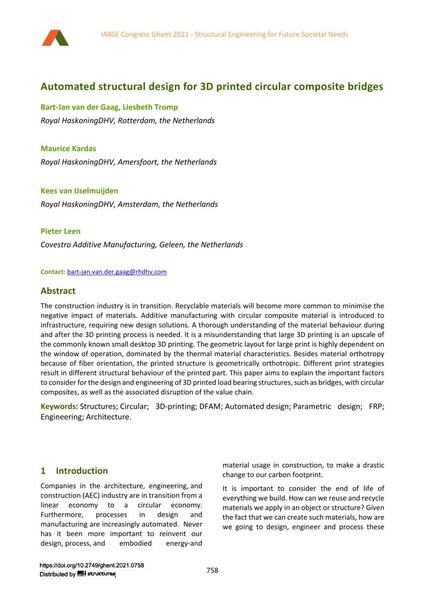Automated structural design for 3D printed circular composite bridges

|
|
|||||||||||
Détails bibliographiques
| Auteur(s): |
Bart-Jan Van der Gaag
(Royal HaskoningDHV, Rotterdam, the Netherlands)
Liesbeth Tromp (Royal HaskoningDHV, Rotterdam, the Netherlands) Maurice Kardas (Royal HaskoningDHV, Amersfoort, the Netherlands) Kees van IJselmuijden (Royal HaskoningDHV, Amsterdam, the Netherlands) Pieter Leen (Covestro Additive Manufacturing, Geleen, the Netherlands) |
||||
|---|---|---|---|---|---|
| Médium: | papier de conférence | ||||
| Langue(s): | anglais | ||||
| Conférence: | IABSE Congress: Structural Engineering for Future Societal Needs, Ghent, Belgium, 22-24 September 2021 | ||||
| Publié dans: | IABSE Congress Ghent 2021 | ||||
|
|||||
| Page(s): | 758-766 | ||||
| Nombre total de pages (du PDF): | 9 | ||||
| DOI: | 10.2749/ghent.2021.0758 | ||||
| Abstrait: |
The construction industry is in transition. Recyclable materials will become more common to minimise the negative impact of materials. Additive manufacturing with circular composite material is introduced to infrastructure, requiring new design solutions. A thorough understanding of the material behaviour during and after the 3D printing process is needed. It is a misunderstanding that large 3D printing is an upscale of the commonly known small desktop 3D printing. The geometric layout for large print is highly dependent on the window of operation, dominated by the thermal material characteristics. Besides material orthotropy because of fiber orientation, the printed structure is geometrically orthotropic. Different print strategies result in different structural behaviour of the printed part. This paper aims to explain the important factors to consider for the design and engineering of 3D printed load bearing structures, such as bridges, with circular composites, as well as the associated disruption of the value chain. |
||||
| Mots-clé: |
structures circulaire
|
||||
| Copyright: | © 2021 International Association for Bridge and Structural Engineering (IABSE) | ||||
| License: | Cette oeuvre ne peut être utilisée sans la permission de l'auteur ou détenteur des droits. |
||||
